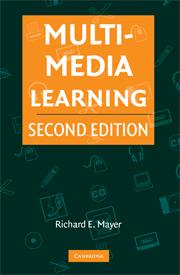Book contents
- Frontmatter
- Contents
- PREFACE
- SECTION I INTRODUCTION TO MULTIMEDIA LEARNING
- SECTION II PRINCIPLES FOR REDUCING EXTRANEOUS PROCESSING IN MULTIMEDIA LEARNING
- 4 Coherence Principle
- 5 Signaling Principle
- 6 Redundancy Principle
- 7 Spatial Contiguity Principle
- 8 Temporal Contiguity Principle
- SECTION III Principles for Managing Essential Processing in Multimedia Learning
- SECTION IV PRINCIPLES FOR FOSTERING GENERATIVE PROCESSING IN MULTIMEDIA LEARNING
- SECTION V CONCLUSION
- REFERENCES
- AUTHOR INDEX
- SUBJECT INDEX
- References
7 - Spatial Contiguity Principle
- Frontmatter
- Contents
- PREFACE
- SECTION I INTRODUCTION TO MULTIMEDIA LEARNING
- SECTION II PRINCIPLES FOR REDUCING EXTRANEOUS PROCESSING IN MULTIMEDIA LEARNING
- 4 Coherence Principle
- 5 Signaling Principle
- 6 Redundancy Principle
- 7 Spatial Contiguity Principle
- 8 Temporal Contiguity Principle
- SECTION III Principles for Managing Essential Processing in Multimedia Learning
- SECTION IV PRINCIPLES FOR FOSTERING GENERATIVE PROCESSING IN MULTIMEDIA LEARNING
- SECTION V CONCLUSION
- REFERENCES
- AUTHOR INDEX
- SUBJECT INDEX
- References
Summary
Spatial Contiguity Principle: Students learn better when corresponding words and pictures are presented near rather than far from each other on the page or screen.
Example: In an animation on lightning formation, captions are presented at the bottom of the screen (separated presentation) or are placed next to the event they describe in the animation (integrated presentation). In a booklet on lightning formation, the text is presented on a different page than the illustrations (separated presentation), or each paragraph is placed next to the illustration it describes (integrated presentation).
Theoretical Rationale: When corresponding words and pictures are near each other on the page or screen, learners do not have to use cognitive resources to visually search the page or screen, and learners are more likely to be able to hold them both in working memory at the same time. When corresponding words and pictures are far from each other on the page or screen, learners have to use cognitive resources to visually search the page or screen, and learners are less likely to be able to hold them both in working memory at the same time.
Empirical Rationale: In five out of five tests, learners performed better on transfer tests when corresponding text and illustrations were placed near each other on the page (or when corresponding on-screen text and animation segments were placed near each other on the screen) than when they were placed far away from each other, yielding a median effect size of d = 1.09.
Information
- Type
- Chapter
- Information
- Multimedia Learning , pp. 135 - 152Publisher: Cambridge University PressPrint publication year: 2009
